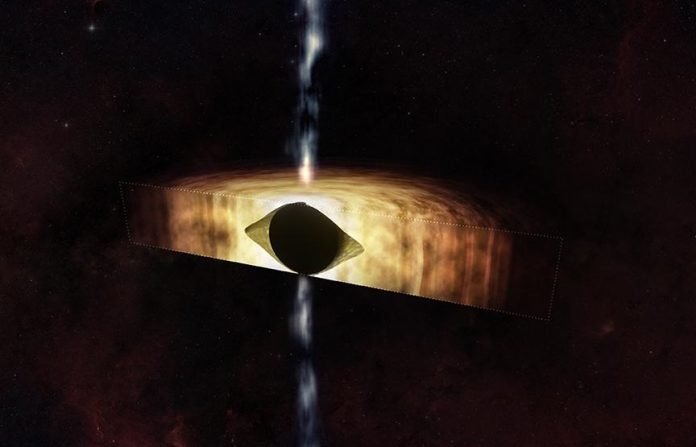
Deep in the heart of our galaxy, the Milky Way, lies a supermassive black hole named Sagittarius A* (Sgr A*).
This colossal space monster, sitting about 26,000 light-years away from Earth, has been a subject of fascination and study for astronomers around the world.
Recent research has revealed something extraordinary about Sgr A*: it’s spinning so fast that it’s warping the space around it, making it resemble the shape of a football.
This groundbreaking discovery comes from a team led by Professor Ruth Daly of Penn State Berks, who used data from NASA’s Chandra X-ray Observatory and the U.S. National Science Foundation’s Very Large Array (VLA).
Their findings, published in the Monthly Notices of the Royal Astronomical Society, show that Sgr A* is spinning at about 60% of its maximum possible speed.
This speed is significant because it suggests that the black hole is not just any ordinary space object but a dynamic entity capable of influencing the very fabric of space and time.
Understanding the spin of a black hole is crucial because it tells us a lot about the black hole’s behavior and its impact on the surrounding galaxy. In the case of Sgr A*, its rapid spin means that it’s pulling and twisting the space around it.
Imagine spacetime as a sheet of rubber: if you twirl a heavy ball placed in the center, the sheet will stretch and distort.
That’s similar to what Sgr A* is doing to the space around it. From above, this distorted space looks circular, but from the side, it looks like a football. The faster the black hole spins, the flatter the football shape becomes.
The research team used a unique method developed by Daly in 2019 to measure how fast Sgr A* is spinning. They looked at X-ray and radio data to see how material flows towards and away from the black hole. This method helped them estimate the black hole’s angular velocity, or how many revolutions it makes per second.
Interestingly, the spin of Sgr A* also has the potential to power jets of matter shooting out from the black hole, known as collimated outflows. These jets can have a significant impact on the galaxy, influencing how stars form and evolve.
Currently, Sgr A* is relatively quiet, with only weak outflows, because there’s not much matter nearby for it to interact with.
However, the team suggests that this could change if more material, such as gas or the remnants of a star, gets too close to the black hole. This interaction could unleash a massive energy outburst, affecting the galaxy on a grand scale.
The study of Sgr A*’s spin is not just an academic exercise; it has practical implications for understanding the history and future of our galaxy.
The presence of Fermi bubbles, large structures emitting gamma rays detected around the Milky Way, hints at past periods of activity from Sgr A*. By measuring the black hole’s spin, astronomers can test theories about these and other cosmic phenomena.
This research opens up exciting possibilities for future studies, offering a glimpse into the dynamic processes at play in the heart of our galaxy. As we continue to observe and understand Sgr A*, we get closer to unraveling the mysteries of the universe, one spin at a time.



